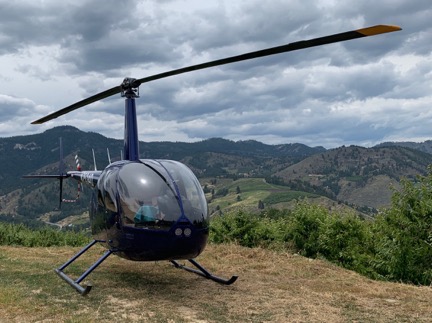A video from the FlyingMAir YouTube channel.
Join me and Trevor Hale, a certified flight instructor from Mesa, AZ, for a 30-minute flight where I practice straight-in and 180° autorotations. Before we finish up, Trevor demonstrates — or tries to demonstrate — the Vuichard Maneuver for recovering from settling with power/vortex ring state. This is a complete video of our flight and includes all conversation, both on topic and off-topic. It’s basically two pilots practicing together, chatting about the maneuvers and sharing flying stories. I considered editing out the downwind portions of each pattern we flew, but thought there was enough interesting chatter to keep it. We’re real people and we’re not trying to prove anything. We’re also not trying to show off, so don’t expect anything fancy.
Because so many folks seem to like the scenic flying I do in the area, I also include my flight to the airport and back to base from the airport. If all you care about are the autorotations, start the video at about 5:00 and end it when Trevor and I land. If you’re here for the scenery, just watch the first and last 5 minutes.
There’s a lot to say about this video and I sure hope folks read this description before they fill the comments with questions I answer here.
First of all, autorotation is a maneuver that helicopter pilots use to land safely in the event of an engine failure. (No, we don’t drop like a brick out of the sky when the engine fails.) Depending on the level of our certificates (private or commercial) we are trained to perform a variety of autorotations, including straight in, 180°, hovering (low), hovering (high), and full-down. We can also be taught more advanced versions that include slipping, spiraling, or making S-turns to hit a spot. In autorotation, the pilot has control of the helicopter and can go in just about any direction except up. (And even that is sometimes possible to a tiny extent.) We are tested on autorotations in check rides and practice it in biennial flight reviews. So yes: every helicopter pilot you fly with should know how to fly the helicopter safely to the ground in the event of an engine failure. If you still think “drop like a brick,” get over it.
I should mention here that if you want to learn how helicopters work, I highly recommend the FAA’s Helicopter Flying Handbook, which is available on the FAA’s website in HTML and PDF formats. This is a free book that tells you everything a helicopter pilot needs to know about flying helicopters in general. (A pilot also needs to know specifics about the helicopter he’s flying; you can find that in the Pilot Operating Handbook (POH) for the aircraft itself.) I’m willing to bet that any question you have about helicopter controls and maneuvers is answered in this book. Please don’t get annoyed if you ask a question in the video comments that’s answered in this book and I don’t answer it.
I’m flying with Trevor on this day to practice autorotations in preparation for an annual FAA Part 135 check flight. Although this will be my 16th or 17th Part 135 check ride, I’m still nervous every time I have one scheduled. I’m not a flight instructor and have never been one. So while a flight instructor practices autorotations almost every day with his students, I don’t. The result: in my 20 years of flying, I’ve done hundreds of practice autorotations when the average helicopter pilot, who was a flight instructor for at least part of his career, has done thousands. Although I’m confident that I could perform a survivable autorotation in the event of an engine failure at altitude — in other words, outside the shaded area of the height velocity diagram (see my blog post about the Deadman’s Curve here) — I like to get practice before a check ride to make sure I can do them within practical test standard requirements for my commercial helicopter certificate. (You can find the FAA’s Commercial Pilot Practical Test Standards for Rotorcraft (FAA-S-8081-16B) as a PDF). The other challenges for me in check ride situations are “text book” flying, which I generally don’t do. I’m referring to flying in traffic patterns at predetermined climb and cruise rates and doing other maneuvers to the exact specifications recommended in text books. Fortunately, pilot examiners understand the difference between text book and real world flying and they don’t usually ding me for sloppy traffic pattern work.
When I edited the video to combine synchronized footage from both cameras, I dialed down the helicopter’s engine/rotor audio to 40% rather than the 25% I usually use. I did this so you can hear how quiet it gets when I throttle down for the autorotation. The engine is still running, but it is not driving the rotor blades. This is how we practice autorotations without putting ourselves or the aircraft at added risk. While practice autorotations can still be dangerous — occasionally an engine actually does quit when you throttle down — keeping the engine running makes it possible to power back up when things start going south — as they started to my first practice 180° autorotation. I don’t practice full-down autorotations in my helicopter because of the increased risk of blade strike on the tail boom in the event of a hard landing. Why risk it? Experienced helicopter pilots might also notice that my flares at the bottom are not very aggressive. That’s because I worry a bit about a tail strike very close to the ground. Again, why risk it?
When Trevor says “bump it,” he’s advising me to lift the collective a tiny bit to prevent rotor overspeed. This is an R44 thing that is not an issue in R22s. There’s so much inertia in the R44’s rotor blades that if you push the collective full down in an autorotation, you run the risk of overspeeding the rotor system. In a real life engine failure, who cares? (We actually allude to that after one of the practice autos.) But when you’re practicing, you don’t want to mess up the helicopter with an overspeed so you’re constantly monitoring rotor RPM to prevent it. (The horn, which I discuss next, will warn you if rotor RPM starts to droop.) On my first practice 180 auto, I came dangerously close to overspeeding, which got me frazzled enough to screw up the rest of the maneuver. In real life engine failures, the only thing you really care about is getting the helicopter on the ground safely, so you’re thinking about keeping RPM high enough to keep flying, make your spot, flare to bleed off airspeed, and cushion your impact when you touch down. The flare will also build RPM, so you want to make sure you’re not already near the redline when you practice.
The sound you hear at the end of some of the autorotations is the low rpm warning system. In a Robinson, it’s set to go off at 97% RPM. That’s an unusually quick warning and part of the reason for that is that early R22 owners were unaccustomed to the low inertia rotor system and the extra early warning was an attempt to help prevent them from getting into unrecoverable low rotor RPM situation. A rule of thumb for Robinsons is that you can fly at 80% RPM plus 1% RPM per 1000 feet of density altitude. So if I’m flying at 2000 feet density altitude — which is about right for that day — the helicopter should stay airborne with just 82% RPM. Years ago, in advanced training at the Robinson Safety Course, the instructor demonstrated this by flying at 90% RPM for a lot longer than my horn-adverse brain wanted to. I blogged about low rotor RPM way back in 2010 here.
Trevor’s biggest problem when trying to demonstrate the Vuichard Maneuver for me (and you) was getting into settling with power/vortex ring state. This normally occurs when a helicopter settles into its own downwash and is the primary reason we don’t land vertically except perhaps at very slow descent rates. To practice a recovery from this condition, you need to get into it. We usually do this by getting into a high hover (zero airspeed) and then starting to descend until the descent rate becomes uncontrollable with the collective. There was simply too much wind that day to really start settling — it was blowing the downwash away from us. Trevor was still able to demonstrate it enough for me to get the gist of it. You can learn more about this maneuver in this Rotor and Wing article by the legendary Robinson flight instructor, Tim Tucker. This excellent article also explains what vortex ring state is and how it can be a problem. It’s a little technical, but so are most aerodynamics topics.
I hope you find the video interesting (at least) and educational (if you’re a pilot who really wants to learn about this). I know it’s not as exciting as the dramatic autorotations you can find in other YouTube videos. I don’t fly like that so if that’s what you come to my channel for, you’ll be disappointed. I believe in flying within my limitations and the limitations of my aircraft. That’s the only thing that can keep me and my passengers safe.


